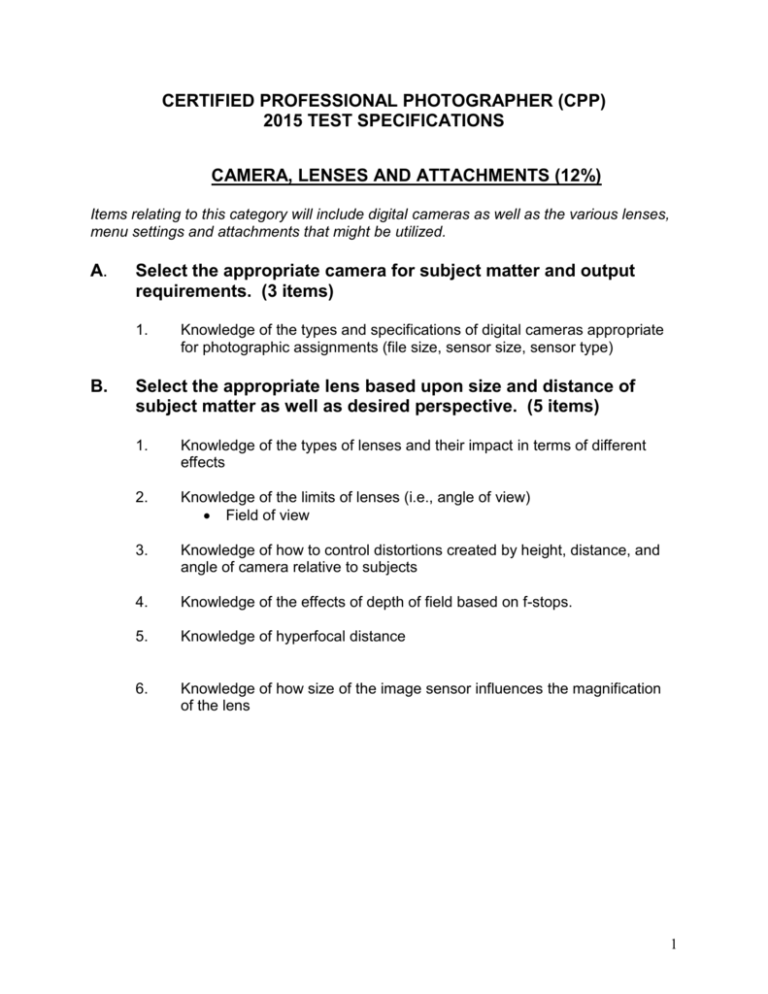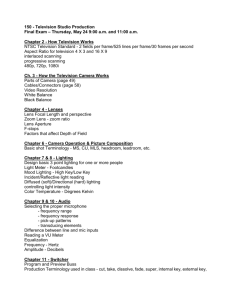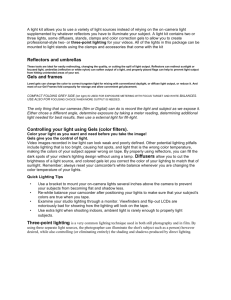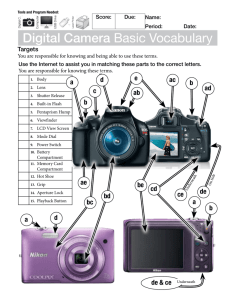CPP Test Specifications - Professional Photographers of America
advertisement

CERTIFIED PROFESSIONAL PHOTOGRAPHER (CPP) 2015 TEST SPECIFICATIONS CAMERA, LENSES AND ATTACHMENTS (12%) Items relating to this category will include digital cameras as well as the various lenses, menu settings and attachments that might be utilized. A. Select the appropriate camera for subject matter and output requirements. (3 items) 1. B. Knowledge of the types and specifications of digital cameras appropriate for photographic assignments (file size, sensor size, sensor type) Select the appropriate lens based upon size and distance of subject matter as well as desired perspective. (5 items) 1. Knowledge of the types of lenses and their impact in terms of different effects 2. Knowledge of the limits of lenses (i.e., angle of view) Field of view 3. Knowledge of how to control distortions created by height, distance, and angle of camera relative to subjects 4. Knowledge of the effects of depth of field based on f-stops. 5. Knowledge of hyperfocal distance 6. Knowledge of how size of the image sensor influences the magnification of the lens 1 C. D. Use camera, camera menu settings, and camera supports to create a quality image. (3 items) 1. Knowledge of camera controls and settings 2. Knowledge of the effects of extreme temperatures or humidity upon operation of equipment 3. Knowledge of appropriate use of camera supports (tripods, gyroscopes, monopods, bean bags, etc) 4. Knowledge of methods used to set white balance White balance target (gray card) Calibration disc Color temperature 5. Knowledge of the impact on file size and format (TIFF, JPEG, Raw, etc) on final image Select and use the appropriate lens attachment (1 item) 1. Knowledge of lens modifiers (bellows, hoods, polarizing filters, protective filters, UV filters, vignetting, neutral density, extension tubes, etc) 2 EXPOSURE AND METERS (15%) Items measuring this set of specifications will include (1) how to meter for the correct exposure; and (2) the relationship between shutter speed and f-stop. A. B. C. Employ a light meter properly to achieve desired exposures. (6 items) 1. Knowledge of proper use of incident, reflective or spot meters 2. Knowledge of the conditions under which meters should be used 3. Knowledge of how to interpret light meter readings Set f/stops and shutter speed based upon exposure and desired effects. (5 items) 1. Knowledge of relationship between shutter speed, f-stop and ISO to produce the desired result f-stop for depth of field, shutter speed for stop action, dragging shutter, control of noise or grain 2. Knowledge of equivalent exposures 3. Knowledge of exposure compensation relative to lighting situations (light absorption and reflection values, skin tones) Verify proper exposure. (4 items) 1. Knowledge of how to use a gray card to achieve exposure value 2. Knowledge of how to read and interpret a histogram 3. Knowledge of exposure compensation 3 LIGHTING (25%) This portion of the examination will measure (1) how to best light the subject; (2) possible types of lighting (Studio, Ambient, Flash, Daylight); (3) lighting design; and (4) lighting equipment. A. B. Evaluate the source(s) of light at the location where subject(s) will be photographed to determine the tools necessary to complete the assignment. (4 items) 1. Knowledge of various light sources and light equipment to created desired effects 2. Knowledge of how to use remote triggering (infrared, photosensitive, or radio) Determine the lighting ratio. (3 items) 1. C. D. Knowledge of establishing desired lighting ratios Understand light modifiers (light blockers, black reflectors, gels, spots, flags, etc.) and their uses. (3 items) 1. Knowledge of use of modification devices to achieve desired effects (gels, reflectors, umbrellas, soft boxes, foil, parabolics, etc) 2. Knowledge of additive and subtractive light Determine the type of lighting design (Rembrandt, split, broad, short, etc.) to be used with the given subject(s). (4 items) 1. Knowledge of soft, hard and diffused light sources for producing desired effects 2. Knowledge of desired light pattern effects that can be obtained on different subjects and/or background (individuals, groups, weddings, tabletop, outdoors, etc.) 3. Knowledge of directing and combining lights (corrective lighting) with different subjects to create desired effects and complement them 4 E. F. G. Determine the appropriate lighting usage (main, fill, etc) for subject(s). (6 items) 1. Knowledge and placement of main/key, fill, background, accent lights to achieve desired effects (control shadows, create depth, enhance subject matter) 2. Knowledge of techniques for controlling/utilizing light (natural light, window, outdoor, studio, mixed, incandescent, florescent, painting with light) 3. Knowledge of backlighting for producing desired effects 4. Knowledge of lighting products (reflective, transparent, translucent, opaque) 5. Knowledge of using flash fill techniques (indoor and outdoor; Sunny 16 rule) 6. Knowledge of on-camera and off-camera flash techniques (TTL, manual, guide numbers) Understand the theory of light. (3 items) 1. Knowledge of the light spectrum, color temperature and color balance 2. Knowledge of the properties of reflectance (angle of reflectance equals angle of incidence, influence on color, etc.) 3. Knowledge of the properties of light (fall-off, size of light source, depth of light, inverse square law, distance to subject, etc.) Select the appropriate filter/gel for color correction of the light source. (1 item) 1. H. Knowledge of filters and gels used for color correction Use lighting techniques as composition and design elements. (1 item) 1. Knowledge of how to coordinate composition and lighting to create the desired effect 2. Knowledge of the use of gels, grids, or cookies to alter the relationship among subjects or products 5 COMPOSITION AND DESIGN (25%) Items relating to this area will focus on the following topics: (1) Subject placement within image area; (2) Special effects, including props; (3) location; (4) clothing; (5) posing; (6) color harmony/color wheel; and (7) coordination of background and subject. A. Determine the best color relationship to complement subject(s) to achieve the desired effects. (4 items) 1. Knowledge of color harmony, interactions, and effects in order to coordinate subjects with backgrounds and enhance the final image Reflective light environment Tonal values, shades and hues Contrast Saturation of color Effect of patterns 2. Knowledge of the color wheel Primary Secondary Tertiary 3. Knowledge of how colors portray mood 4. Knowledge of color schemes: Achromatic Clash Neutral Split Complementary Monotone Analogous Monochromatic Harmonious Complementary 5. Facets of color: Warm Cold Bright Pale Hot Light Dark Recede (cool) versus Project (warm) 6 B. Analyze the natural environment to complement subject(s) to achieve the desired effects. (4 items) 1. C. D. E. Knowledge of how to adapt to the environment (understand the environment to achieve a photographic advantage) Color harmony Patterns Subject placement Direction of lighting Distractions Balance Frame or crop the picture within the camera’s viewfinder. (2 items) 1. Knowledge of cropping pictures to create desired effects 2. Knowledge of aspect ratios Use angle of view to produce the desired effect (mood, power, size, strength, etc). (6 items) 1. Knowledge of perspective effects and how to achieve these effects (perspective, camera angle, camera position) 2. Knowledge of the elements of composition that create different effects (Rule of thirds, leading lines, positive/negative space, etc) Position subject(s) with selected background, special effects, and props to achieve the desired effect. (3 items) 1. Knowledge of how to compose the elements within a scene to create the desired effect 2. Knowledge of using props as complementary accessories to the subject matter 3. Knowledge of how to achieve what the client desires – scenarios 7 F. Pose individuals and multiple subjects to achieve the most flattering results (6 items) 1. Feminine/masculine posing 2. Group posing (Pyramid, triangular, spacing, connection) 3. Facial Views (full face, 2/3, profile) 4. Body posing (Breaking the plane [Rule of 2] and weight placement) 8 DIGITAL POST PRODUCTION (13%) Items measuring this specification will include: (1) color space; (2) file formats and resolution; (3) color management; (4) digital manipulation and (5) storage. Basic knowledge of post-production software will be necessary. A. B. C. D. E. Understand the best color space in which to work. (1 item) 1. Knowledge of color spaces (RGB, CMYK, sRGB, Adobe RGB 1998, Pro Photo RGB) 2. Knowledge of color space for printing and reproduction Select appropriate file format. (2 items) 1. Knowledge of file formats (TIFF, DNG, JPEG, EPS, PSD, PNG ,GIF, RAW, etc) 2. Knowledge of PPI versus DPI Create/employ a color management system. (4 items) 1. Knowledge of monitor calibration and viewing characteristics 2. Knowledge of color/ICC profiles Select appropriate file management and archival systems. (2 items) 1. Knowledge of back-up/archive media 2. Knowledge of computer operations (RAM, storage, virtual memory) Manipulate digital images (4 items) 1. Knowledge of available techniques to manipulate digital images (exposure, color correction/balance, adjusting levels, details, dodge & burn, etc.) 2. Knowledge of cause and effect in the manipulation of digital images 9 IMAGE CAPTURE AND OUTPUT (10%) Items included in this section will measure of image capture and output options (paper, electronic, web, etc.). A. B. C. Select the appropriate capture device for subject matter, format requirements, and final job requirements. (4 items) 1. Knowledge of appropriate use and effects of different ISO values (noise) 2. Knowledge of file size relative to enlarging capabilities 3. Knowledge of appropriate selection of capture file format (JPEG, RAW) 4. Knowledge of the various capture media (compact flash, write speed, micro drives, etc) Identify and correct problems in images. (2 items) 1. Knowledge of possible problems in image capture (white balance, dust spot on chip, flash synchronization, etc) 2. Knowledge of how to correct problems in image capture (white balance, moiré, noise reduction, lens flare, sharpening chromatic aberration, etc) Output/Print image to desired medium. (4 items) 1. Knowledge of file sizes relative to final output 2. Knowledge of the necessary instructions (use of cropping guides, monochrome vs color preference, etc) to provide the lab 3. Knowledge of the different output devices relative to the reproduction requirements (scanning, printer, web, printing press) 4. Knowledge of different delivery methods (CD, DVD, paper, FTP, internet, etc) 5. Knowledge of resolution required for output (ink jet, photo lab, Dye sublimation printers, and web, etc.) 6. Knowledge of output devices and longevity 10






